Key takeaways:
- Organic wine production emphasizes natural farming methods, enhancing biodiversity and soil health while eliminating synthetic inputs.
- Permaculture practices significantly improve vineyard ecosystems, promoting water conservation, biodiversity, and healthier grape growth.
- Implementing companion planting, natural mulch, and integrating animal life in vineyards fosters sustainable practices and enhances soil vitality.
- Personal experiences with organic methods illustrate the balance of nature, community collaboration, and the joy of transforming waste into valuable resources.
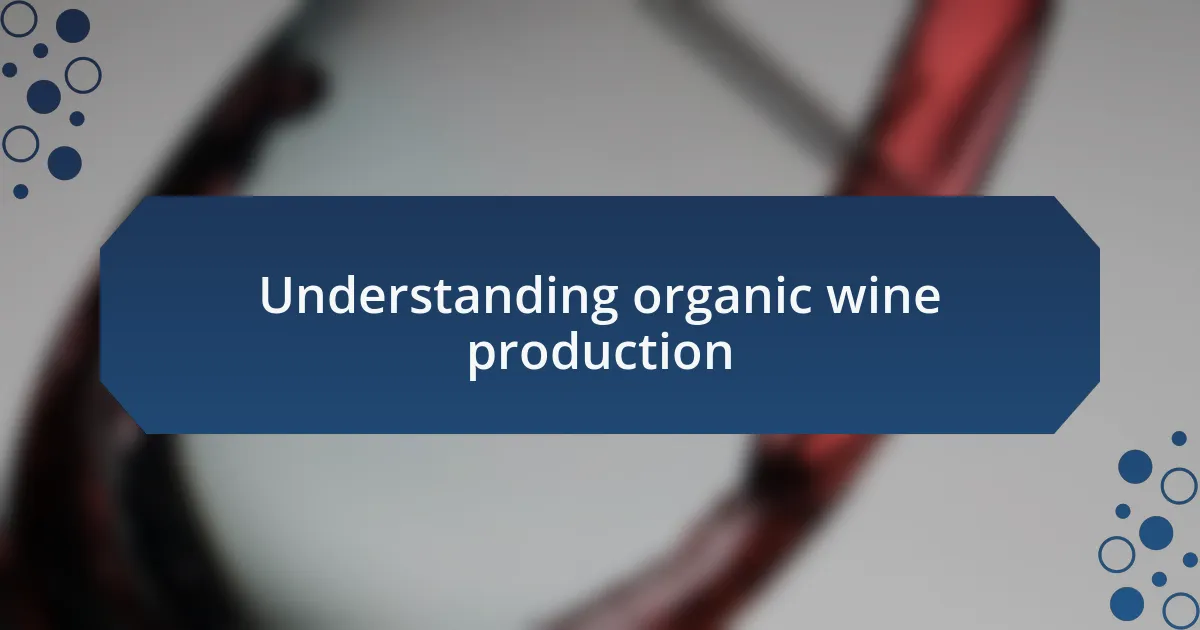
Understanding organic wine production
Organic wine production is rooted in a commitment to environmental sustainability and a deep respect for the land. I still remember my first visit to an organic vineyard, where the vibrant soil and lush vines seemed to thrive with life. It made me wonder, how can our farming practices not only yield great grapes but also nourish the earth?
The essence of organic wine lies in the use of natural farming methods, which prioritize biodiversity and healthy ecosystems. I often think about the moment I tasted a biodynamic wine, a product of these practices, and it felt like I was sipping the essence of the land itself. Isn’t it fascinating how the way grapes are grown can influence their flavor profile so significantly?
Additionally, organic wine production prohibits synthetic pesticides and fertilizers, allowing for a purer expression of the terroir—the unique characteristics imparted by the vineyard’s environment. I have seen firsthand how this approach fosters stronger relationships between winemakers and their surroundings, leading to wines that tell a story of their origin. Have you ever considered how the practices behind the wine can enrich its taste and your appreciation of it?
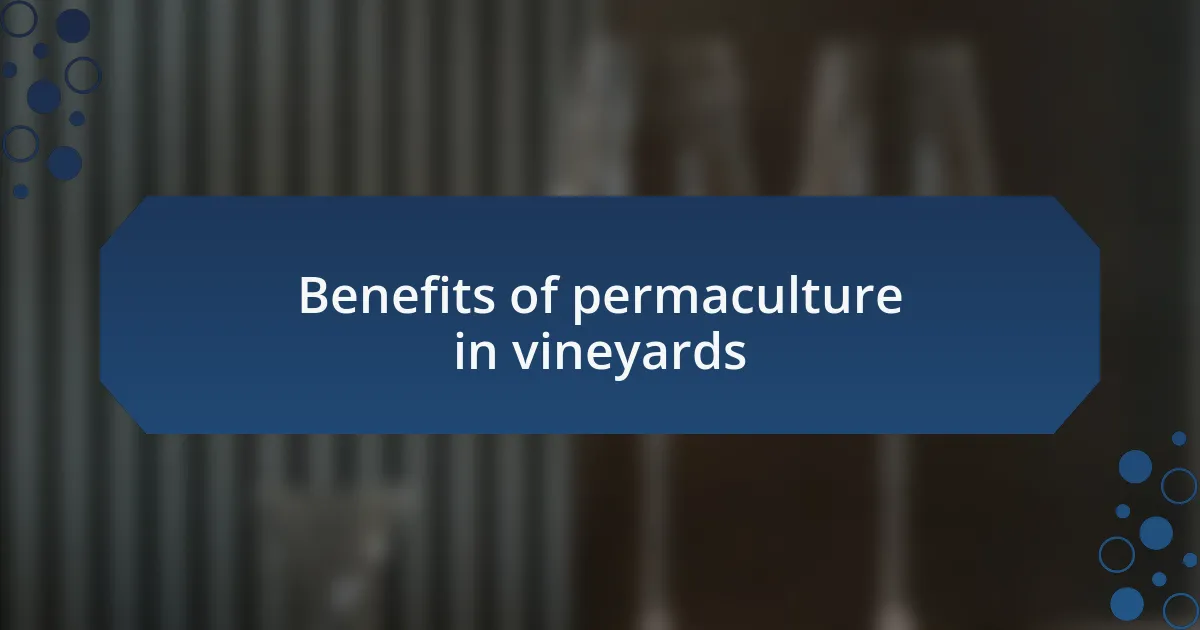
Benefits of permaculture in vineyards
The integration of permaculture in vineyards offers remarkable benefits, particularly in promoting biodiversity. I remember walking through a vineyard that applied these principles, surrounded by a variety of plants and wildlife. It struck me how this diversity not only enhanced the ecosystem but also attracted beneficial insects, leading to a more balanced environment. Could this natural harmony be the secret ingredient for healthier grapes?
Moreover, permaculture practices enhance soil health, which is vital for producing high-quality grapes. I’ve seen how cover crops—like clover and vetch—can enrich the soil naturally. It’s fascinating to think that by nurturing the soil, we’re nurturing the vines. Isn’t it incredible how just a few changes in our practices can yield a more robust crop?
Finally, the water management techniques encouraged by permaculture, such as swales and rain gardens, help to conserve water while managing runoff effectively. When I observed a vineyard utilizing these features, I was amazed at how efficiently they harvested rainwater—transforming a potential waste into a resource. Isn’t this approach indicative of a broader shift towards sustainable agriculture, where every drop counts?
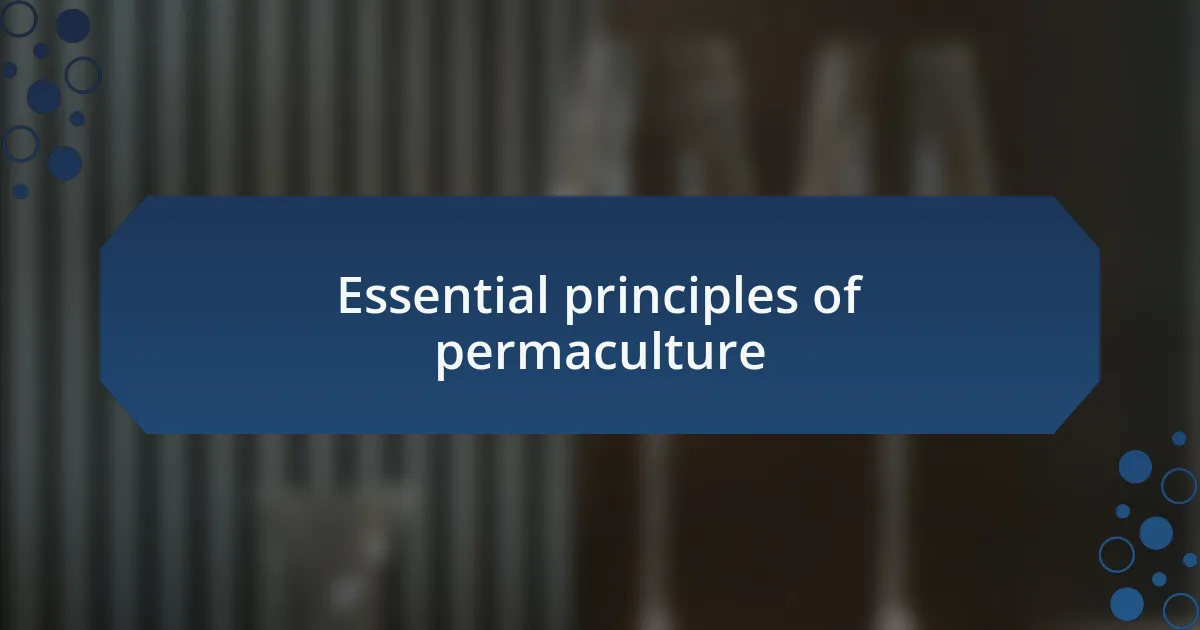
Essential principles of permaculture
Permaculture is grounded in key principles that guide sustainable practices. One essential aspect is the concept of “working with nature” rather than against it. I’ve often found myself considering how this philosophy transforms our approach to agriculture. For instance, while observing a vineyard that emphasized natural pest control, I noticed how vibrant ecosystems emerged—each organism playing its part in maintaining balance. Can we truly appreciate how interconnected our agricultural practices are with nature?
Another principle centers around observation and interaction. In my experience, spending time in the vineyard to truly understand the land forms a critical connection. I recall a moment when I paused to watch how sunlight danced across the vines during different times of the day. This deepened my awareness of the microclimates present in the vineyard, influencing where to plant specific varieties. Isn’t it fascinating how such simple moments can unveil the hidden potential of our spaces?
Lastly, the practice of integrating perennial plants into the landscape is incredibly impactful. I remember helping to plant mulberry trees alongside grapevines—those trees not only provided shade but also supported diverse wildlife. This approach reinforces the idea that every element in a permaculture system has a purpose and contributes to the overall harmony. How often do we forget that even the smallest changes can yield significant benefits in the long run?
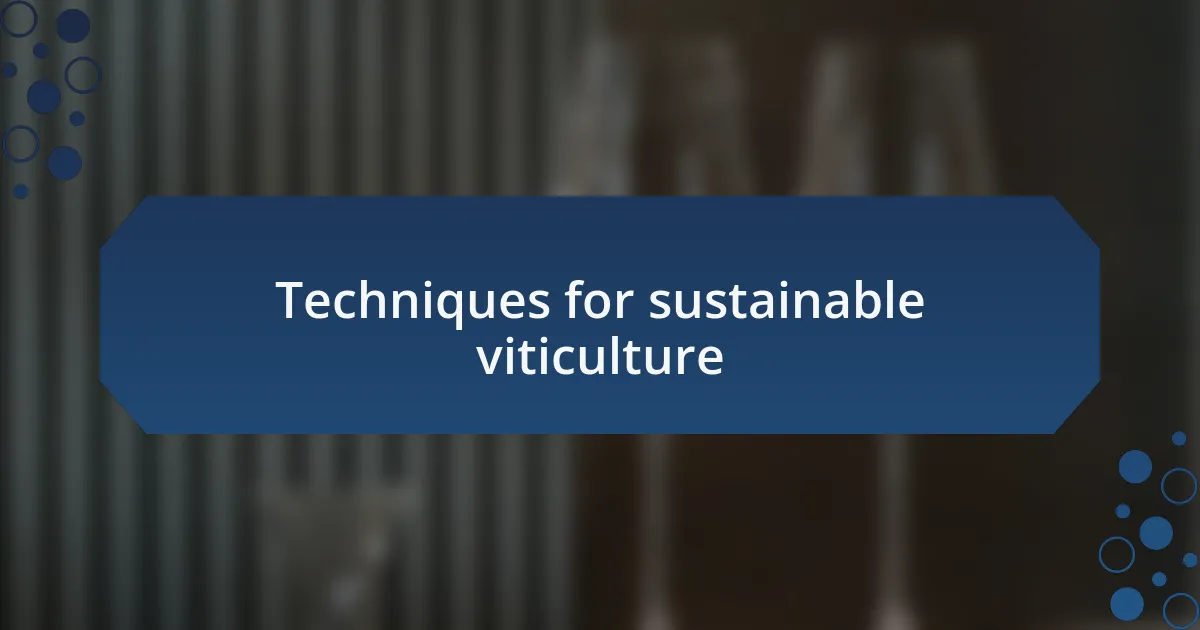
Techniques for sustainable viticulture
One effective technique I’ve embraced in sustainable viticulture is the use of cover crops. When I first experimented with planting clover between the rows of grapevines, I was amazed at the transformation. Not only did it suppress weeds, but the clover also fixed nitrogen in the soil, enhancing fertility. Have you ever noticed how a simple planting strategy can have such a profound impact on soil health?
Integrating biodiversity into the vineyard is another powerful method I’ve employed. I fondly remember introducing wildflowers along the edges of the vineyard, which not only attracted beneficial insects but also added stunning visuals to the landscape. It was uplifting to see how this diversity created a more resilient ecosystem—nature thrives with variety. Have you considered how diversifying your vineyard can improve not just aesthetics but also productivity?
Additionally, implementing water conservation techniques significantly transformed my viticulture approach. I recall installing drip irrigation, which allowed precise water application directly to the roots. This not only reduced water waste but also promoted healthier vine growth. Isn’t it interesting how a small shift in irrigation can lead to such substantial improvements in both sustainability and grape quality?
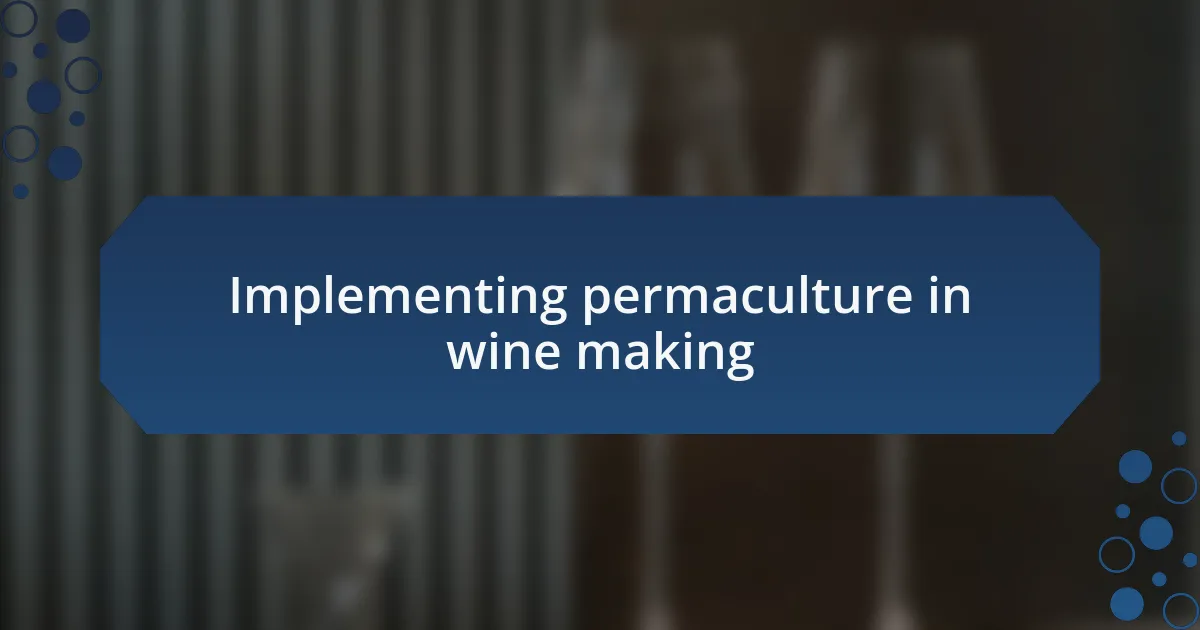
Implementing permaculture in wine making
Implementing permaculture in winemaking has been a game-changer for my vineyard. I vividly remember the first time I designed a guild around my grapevines, planting companion plants like garlic and herbs that not only complemented the vines but also repelled pests. It’s fascinating to see how nature’s relationships can foster healthier ecosystems—have you experienced the synergy that comes from thoughtfully planning plant interactions?
One of my most rewarding experiences was utilizing natural mulch to enhance soil quality and moisture retention. I chose to incorporate straw and wood chips, which over time transformed into a rich organic matter. Watching the earth beneath the vines feel alive again was incredibly gratifying. Isn’t it amazing how such a simple practice can rejuvenate the ground?
The integration of animal life into my vineyard has brought unexpected benefits. I decided to introduce chickens to help manage pests naturally while providing nutrient-rich manure for my vines. Their presence has not only controlled pest populations but also created a lively atmosphere in the vineyard. Have you thought about how incorporating animals could change the dynamics of your own farming practices?
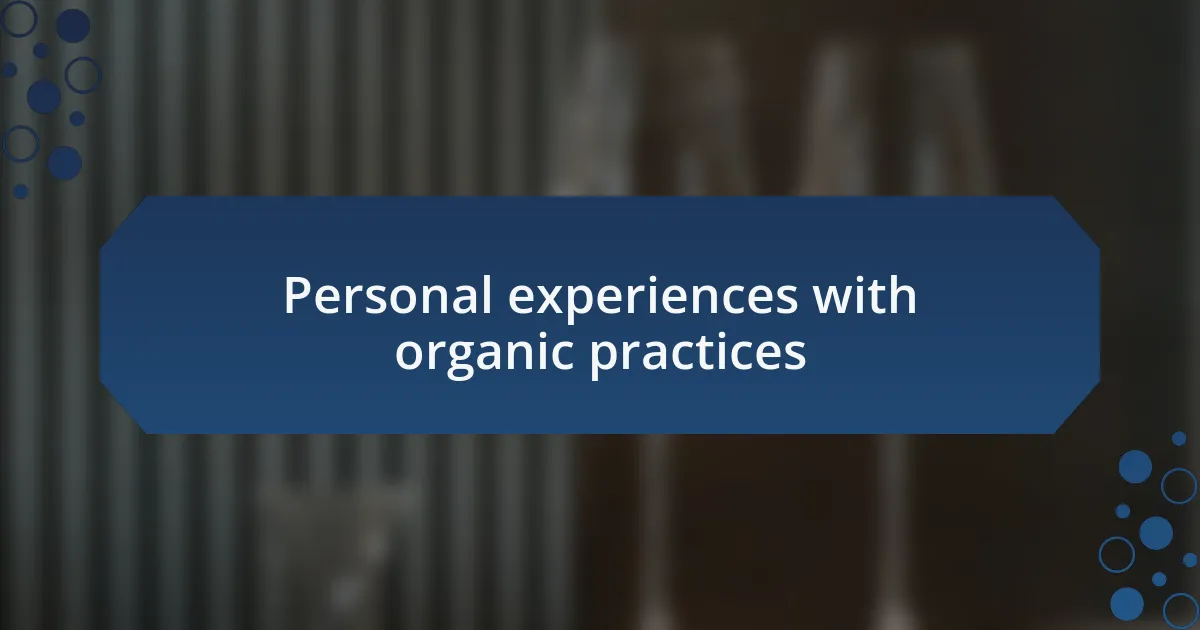
Personal experiences with organic practices
Working with organic practices has truly reshaped my relationship with the land. I recall one particularly challenging season when I opted for organic pest control methods instead of conventional chemicals. My heart raced as I watched the ladybugs I’d introduced flourish, effectively keeping aphid populations at bay. It’s moments like these that make me appreciate the delicate balance of nature—how often do we overlook the solutions that lie right before us?
Another poignant experience was the transition to organic composting, which became more than just a farming technique for me. As I layered kitchen scraps with vineyard clippings, I witnessed the transformation from waste into life-giving fertilizer. This process ignited a sense of purpose within me; it wasn’t just about feeding the vines but about nurturing the earth. Have you ever found joy in turning your own waste into something valuable?
Reflecting on my organic practices, I can’t help but think of the sense of community it fosters. Collaborating with local farmers to exchange organic materials and knowledge has enriched my journey. Each interaction becomes a learning opportunity, reinforcing my commitment to sustainability. I often wonder how we can further connect with others to bolster our organic efforts—what might your contribution look like?